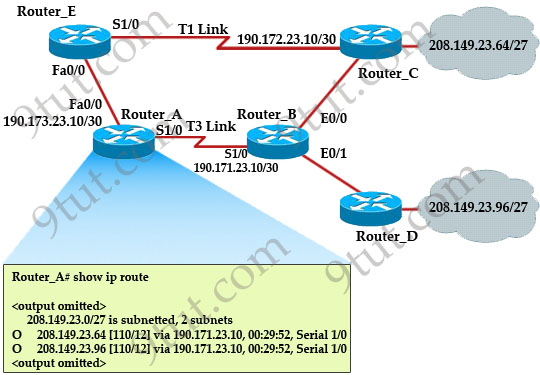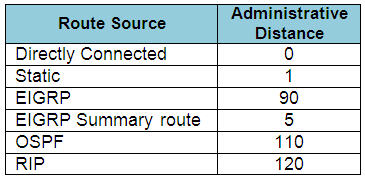ICND2 – OSPF Questions 2
[am4show have=’p2;’]
Premium Member: You can test your knowledge with these questions first via this link.
[/am4show]
Question 1
[am4show have=’p2;’]Refer to the exhibit. The network is converged. After link-state advertisements are received from Router_A, what information will Router_E contain in its routing table for the subnets 208.149.23.64 and 208.149.23.96?

A. 208.149.23.64[110/13] via 190.173.23.10, 00:00:00:07, FastEthernet0/0
208.149.23.96[110/13] via 190.173.23.10, 00:00:00:16, FastEthernet0/0
B. 208.149.23.64[110/1] via 190.173.23.10, 00:00:00:07, Serial1/0
208.149.23.96[110/3] via 190.173.23.10, 00:00:00:16, FastEthernet0/0
C. 208.149.23.64[110/13] via 190.173.23.10, 00:00:00:07, Serial1/0
208.149.23.96[110/13] via 190.173.23.10, 00:00:00:16, Serial1/0
208.149.23.96[110/13] via 190.173.23.10, 00:00:00:16, FastEthernet0/0
D. 208.149.23.64[110/13] via 190.173.23.10, 00:00:00:07, Serial1/0
208.149.23.96[110/13] via 190.173.23.10, 00:00:00:16, Serial1/0
Answer: A[/am4show]
Explanation
Router_E learns two subnets subnets 208.149.23.64 and 208.149.23.96 via Router_A through FastEthernet interface. The interface cost is calculated with the formula 108 / Bandwidth. For FastEthernet it is 108 / 100 Mbps = 108 / 100,000,000 = 1. Therefore the cost is 12 (learned from Router_A) + 1 = 13 for both subnets -> B is not correct.
The cost through T1 link is much higher than through T3 link (T1 cost = 108 / 1.544 Mbps = 64; T3 cost = 108 / 45 Mbps = 2) so surely OSPF will choose the path through T3 link -> Router_E will choose the path from Router_A through FastEthernet0/0, not Serial1/0 -> C & D are not correct.
In fact, we can quickly eliminate answers B, C and D because they contain at least one subnet learned from Serial1/0 -> they are surely incorrect.
Question 2
[am4show have=’p2;’]What OSPF command, when configured, will include all interfaces into area 0?
A. network 0.0.0.0 255.255.255.255 area 0
B. network 0.0.0.0 0.0.0.0 area 0
C. network 255.255.255.255 0.0.0.0 area 0
D. network all-interfaces area 0
Answer: A[/am4show]
Explanation
The ‘network … area …’ command under OSPF process has the following meaning: It searches all the active interfaces, if the IP address of that interface belong to the ‘network …’ configured under OSPF process then the router will run OSPF on that interface. Therefore when we configure ‘network 0.0.0.0 255.255.255.255 area 0’ command, all interfaces are matched -> OSPF is enabled on all active interfaces on the router.
Question 3
[am4show have=’p2;’]What are two benefits of using a single OSPF area network design? (Choose two)
A. It is less CPU intensive for routers in the single area.
B. It reduces the types of LSAs that are generated.
C. It removes the need for virtual links.
D. It increases LSA response times.
E. It reduces the number of required OSPF neighbor adjacencies.
Answer: B C[/am4show]
Question 4
[am4show have=’p2;’]What can cause two OSPF neighbors to be stuck in the EXSTART state?
A. There is a low bandwidth connection between neighbors.
B. The neighbors have different MTU settings.
C. The OSPF interfaces are in a passive state.
D. There is only layer one connectivity between neighbors.
Answer: B[/am4show]
Question 5
[am4show have=’p2;’]Which parameter or parameters are used to calculate OSPF cost in Cisco routers?
A. Bandwidth, Delay and MTU
B. Bandwidth
C. Bandwidth and MTU
D. Bandwidth, MTU, Reliability, Delay and Load
Answer: B[/am4show]
Explanation
The well-known formula to calculate OSPF cost is
Cost = 108 / Bandwidth
so B is the correct answer.
Question 6
[am4show have=’p2;’]What is the default maximum number of equal-cost paths that can be placed into the routing of a Cisco OSPF router?
A. 16
B. 2
C. unlimited
D. 4
Answer: D[/am4show]
Explanation
The default number of equal-cost paths that can be placed into the routing of a Cisco OSPF router is 4. We can change this default value by using “maximum-paths” command:
Router(config-router)#maximum-paths 2
Note: Cisco routers support up to 16 equal-cost paths
Question 7
[am4show have=’p2;’]What information does a router running a link-state protocol use to build and maintain its topological database? (Choose two)
A. hello packets
B. SAP messages sent by other routers
C. LSAs from other routers
D. beacons received on point-to-point links
E. routing tables received from other link-state routers
F. TTL packets from designated routers
Answer: A C[/am4show]
Explanation
Link-state protocol uses hello packets to discover neighbors and establish adjacencies. After that, the routers begin sending out LSAs to every neighbor (each received LSA is copied and forwarded to every neighbor except the one that sent the LSA)
Question 8
[am4show have=’p2;’]Refer to the exhibit.

If the router Cisco returns the given output and has not had its router ID set manually, what value will OSPF use as its router ID?
A. 192.168.1.1
B. 172.16.1.1
C. 1.1.1.1
D. 2.2.2.2
Answer: D[/am4show]
Question 9
[am4show have=’p2;’]What is the default administrative distance of OSPF?
A. 90
B. 100
C. 110
D. 120
Answer: C[/am4show]
Explanation
The Administrative Distances (AD) of popular routing protocols are listed below:

Question 10
[am4show have=’p2;’]When a router undergoes the exchange protocol within OSPF, in what order does it pass through each state?
A. exstart state > loading state > exchange state > full state
B. exstart state > exchange state > loading state > full state
C. exstart state > full state > loading state > exchange state
D. loading state > exchange state > full state > exstart state
Answer: B[/am4show]


Are there any OSPF IPv6 questions on current 200-125 or 200-105 exams?
Why isn’t the answer for question 8 C?
@JJ.
If there is no OSPF Router ID configured, the highest IP address on any of the Routers Loopback Interfaces is selected as the OSPF Router ID.
The correct answer for Q6 is 4? I’m a little confused because Cisco says that by default the path-cost is 16.
https://www.cisco.com/c/en/us/td/docs/routers/xr12000/software/xr12k_r4-1/routing/configuration/guide/routing_cg41xr12k_chapter4.html
@JJ It always uses the highest loopback IP as RID if enabled.
where can I find 100% free latest dumps?
Please help me !!!!!!!!!!!!!!!!!!!!!!!!!!!!!
q. 1
Router_E learns two subnets subnets 208.149.23.64 and 208.149.23.96 via Router_A through FastEthernet interface. The interface cost is calculated with the formula 108 / Bandwidth. For FastEthernet it is 108 / 100 Mbps = 108 / 100,000,000 = 1. Therefore the cost is 12 (learned from Router_A) + 1 = 13 for both subnets -> B is not correct.
How is it 12???
nvm saw that it is just Ethernet not fast Ethernet
Passed, if you go the exam study the 486q dumps.
Thanks Julius! Congrats.
@Julius, what do you mean by 486q dumps?
what is 486q dumps?